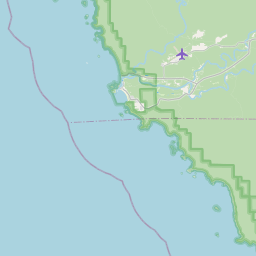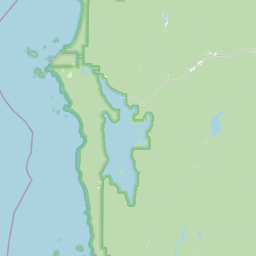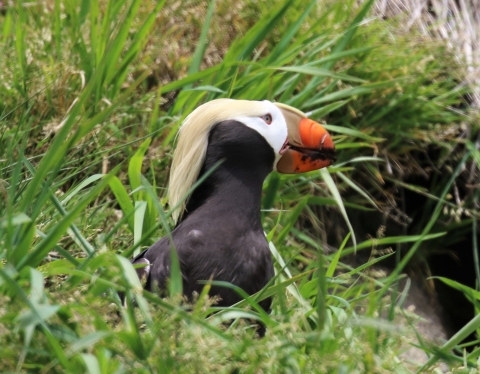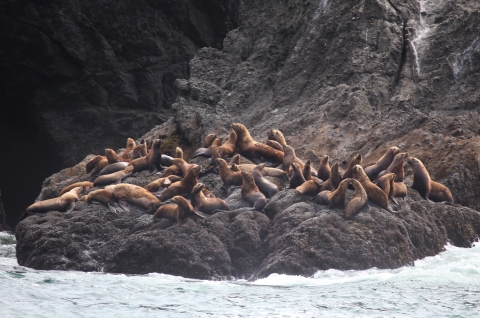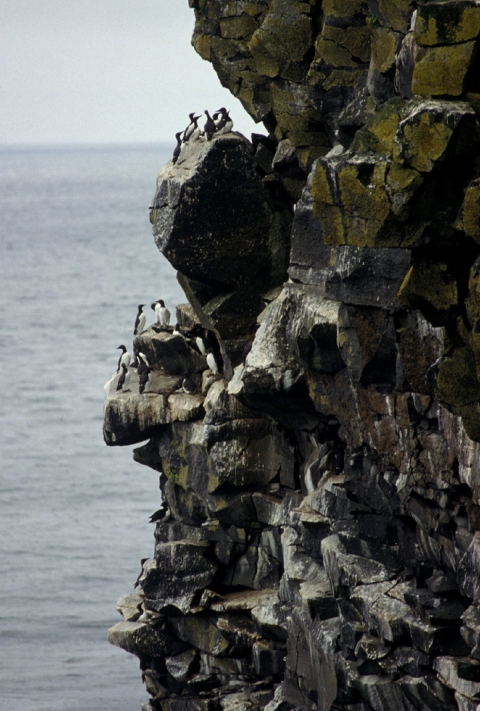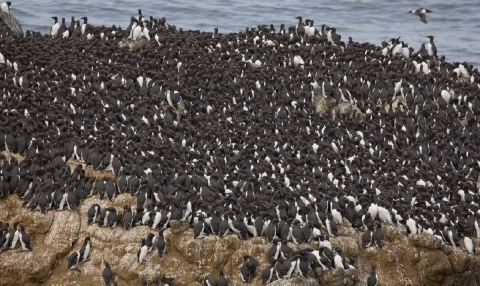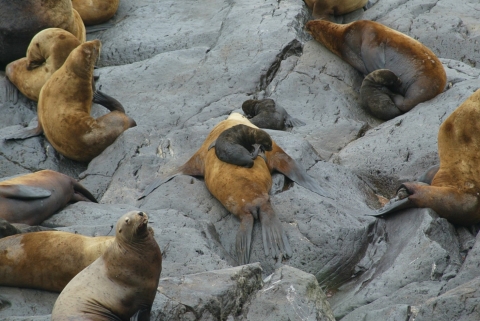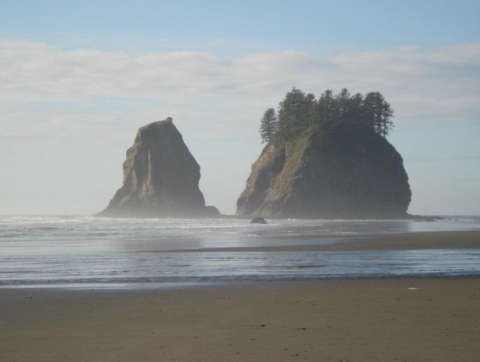To prevent disturbance to extremely sensitive seabirds and marine mammals; Copalis, Flattery Rocks, and Quillayute Needles National Wildlife Refuges are closed to all public access and the surrounding waters within 200 yards are closed to all watercraft.
Along with Flattery Rocks and Copalis, Quillayute Needles was set aside by Teddy Roosevelt in 1907 as one of the earliest National Wildlife Refuges in an effort to protect and enhance habitat for struggling seabird populations. Together these refuges have been designated wilderness and include approximately 800 off-shore rocks, reefs and islands stretching from Cape Flattery in the north to just south of Copalis Head, excepting those that are part of designated Native American reservations.
Today the islands swell with raucous flocks of migrating seabirds in excess of a million during fall and spring migrations. In summer the vast majority of Washington’s breeding seabirds jostle for space on these remote rocks. Black oystercatchers tend pebbly nests at the water’s edge, common murres lay gravity defying eggs on barren ledges, and tufted puffins burrow their nests deep into the loamy bluffs. Kelp beds surrounding the islands provide territory for a growing reintroduced sea otter population to cavort.
Visit Us
Because of the fragile and remote nature of the refuge, all the islands are closed to human disturbance. A 200-yard buffer zone surrounds each island to protect the wildlife. However, the refuges and their inhabitants may be viewed with binoculars or spotting scopes from several beaches along the coast, including Shi Shi, Cape Alava, Rialto, Second, Ruby, and Kalaloch.
Location and Contact Information
- Quillayute Needles National Wildlife Refuge
About Us
Quillayute Needles National Wildlife Refuge is one of six Refuges that make up the Washington Maritime National Wildlife Refuge Complex. Collectively, Quillayute Needles, along with Flattery Rocks and Copalis National Wildlife Refuges, are referred to as the Washington Islands National Wildlife Refuges and total over 430 acres. They are managed to preserve and protect habitat for seabirds and other wildlife.
Washington Islands Wilderness Area
In 1970, the United States Congress designated the Washington Islands National Wildlife Refuges as wilderness. Located off Washington’s Olympic Coast, the designation includes all rocks, reefs, and islands stretching from Cape Flattery all the way south to Copalis, except for Destruction Island and those that are designated part of Native American reservations. These wilderness islands provide nesting habitat for more than 70 percent of Washington's seabirds and support some of the largest seabird colonies in the continental United States. To prevent disturbance to extremely sensitive seabirds and marine mammals, Washington Islands Wilderness is closed to public entry year-round and the surrounding waters within 200 yards are closed to all watercraft.
For more information about Washington Islands Wilderness, visit wilderness.net.
What We Do
Resource Management
The isolation of these islands offers a multitude of seabirds and sea mammals protection from human disturbance and terrestrial predators to maintain healthy populations. Like an iceberg, these islands are the visible part of a vast, complex life-supporting structure structure
Something temporarily or permanently constructed, built, or placed; and constructed of natural or manufactured parts including, but not limited to, a building, shed, cabin, porch, bridge, walkway, stair steps, sign, landing, platform, dock, rack, fence, telecommunication device, antennae, fish cleaning table, satellite dish/mount, or well head.
Learn more about structure . Although the islands themselves do not move, the surrounding waters move with currents and tides bringing nourishing resources that sustain the local inhabitants.
These islands support the majority of all the nesting seabirds on the outer coast of Washington. Some of the birds that use the islands include: common murres, Leach’s storm-petrels, rhinoceros auklets, and Cassin’s auklets. Sea mammals include: California sea lions, harbor seals, sea otters, and Stellar sea lions.
The Refuge primarily monitors these wildlife populations through aerial surveys. Additionally, Refuge staff collaborate with the staffs of the Olympic Coast National Marine Sanctuary and Olympic National Park on research programs and other issues that may have impacts on the resources.
The Copalis, Flattery Rocks and Quillayute Needles Refuges, parts of which are designated as the Washington Islands Wilderness, are closed to visitation to protect wildlife and other natural, cultural, and other resources consistent with the conservation purposes of the refuges.
Our Organization
Washington Maritime National Wildlife Refuge Complex
Quillayute Needles National Wildlife Refuge is managed as one of six refuges in the Washington Maritime National Wildlife Refuge Complex. A National Wildlife Refuge Complex is an administrative grouping of two or more refuges, wildlife management areas or other refuge conservation areas that are primarily managed from a central office location. Refuges are grouped into a complex structure structure
Something temporarily or permanently constructed, built, or placed; and constructed of natural or manufactured parts including, but not limited to, a building, shed, cabin, porch, bridge, walkway, stair steps, sign, landing, platform, dock, rack, fence, telecommunication device, antennae, fish cleaning table, satellite dish/mount, or well head.
Learn more about structure because they occur in a similar ecological region, such as a watershed or specific habitat type, and have a related purpose and management needs.
Typically, a project leader or complex manager oversees the general management of all refuges within the complex while refuge managers may be responsible for operations at specific refuges. Supporting staff are generally, but not always, centrally located and support all refuges within the complex.
The Washington Maritime Complex is headquartered at the Dungeness National Wildlife Refuge near Sequim, WA.
Our Species
The rocks and islands along Washington's outer coast provide vital habitat for nesting and migrating bird populations. These sentinels are home to some of the country's largest seabird breeding populations. In addition, marine mammals feed in the waters surrounding the islands and rest on the low crags.
Birds
Thousands of birds utilize the refuge islands for diverse purposes including raising young, resting during migration, and protection from predators.
Marine Mammals
The coastal waters surrounding the islands are rich in food resources for the variety of marine mammal species that call this refuge home.
From sheer cliffs to gnarled trees, many species find a niche to occupy on these islands.



